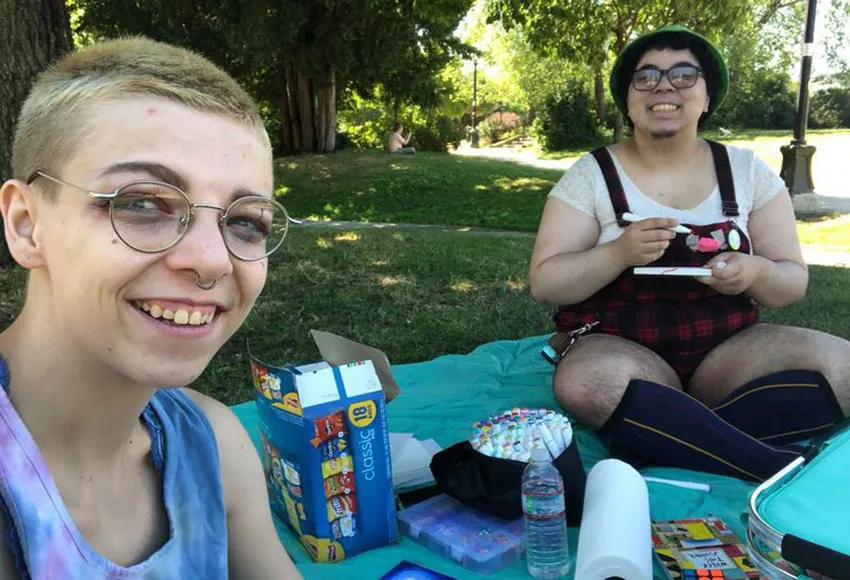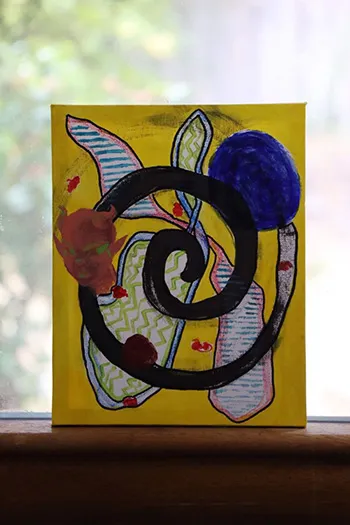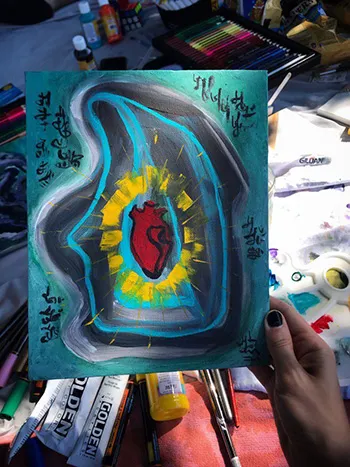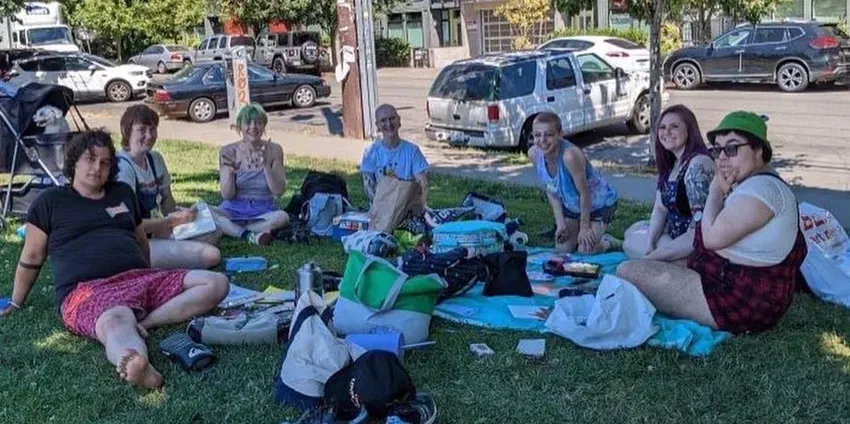Seattle's Queer Art Club first started meeting in Cal Anderson Park in late July; from there, the founders' vision has only continued to expand.
Within three meetings – largely promoted over social media and through friends – the turnout has already grown more than expected, said Olive Baxley, a Genderfluid Seattle-based abstract artist and co-founder of the club. Baxley uses he/him and she/her pronouns.
During the first meeting, there were nine in attendance, and by the next, it had nearly doubled. Some had heard from their friends in person or from online artist acquaintances, and others dropped in after walking by in the park.

An art space "by Queers, for Queers"
In partnership with August Jasper, Baxley founded QAC as an art space "by Queers, for Queers" to create, collaborate, and build community.
Leo Harris, an attendee who also helped organize the August 30 meeting, described the club as "very open, very welcoming – a lot of different backgrounds, a lot of people with very different art styles and skill levels. There was absolutely no judgment, no comparison."
Harris attributes this openness to QAC being a Queer-dedicated venue, rather than just "LGBTQ+ friendly." He said he sees it as a "better space for self-expression," one where "there's just more freedom to engage at that level that is comfortable for you to not mask quite as much. ...You can create alongside people who are like you and who relate to you."
"I think in cis-het-dominated spaces, there are certain expectations of performing gender a certain way," he added. "Where[as] in Queer spaces, there's just a lot less of it – and there's more freedom that comes with that."
Baxley further emphasized the importance of having Queer-dedicated venues, even in creative forums, which she says are "in general very open."
"It's important to me because I want to feel safe," she said. "I want to offer a safe space [for Queer people]... to know that their identity in their art is important and valid and valued and can be seen."
And for Bamber Southorn, an attendee and artist who moved to Seattle in 2021, being at QAC "means being with like-minded people. Of course, there was talk about people's Queer identity [and] experience. But there is a sense of comfort in knowing you won't have to explain your choice in pronouns."

Building community through shared experiences and interests
This sense of safety and comfort promotes a desire for community building, said Baxley. "The first [collaborative art piece] wasn't really planned. I was just like: 'I don't want to do any more of this, do you want to add something?' and just pass[ed] it around."
After the first meeting, collaborative pieces became a tradition in addition to the personal art pieces attendees make.
"There's never a rule or not really a guide; it's just whatever you want, mixed mediums... painting ... word art. We've had people do crochet... All styles [are] welcome," Baxley said.
And QAC features not only a diverse range of art styles but also experience levels. "I've found myself telling a lot of people about Queer Art Club, including people who normally don't see themselves as artists," said Harris. "I feel like it's been a really great space for people to explore artistic expression, no matter where they are with it."

Expressing Queer identities through art
For many, part of exploring their artistic expression is through various styles and compositions. For others, it's through the evolution of the experiences and stories they tell, or even a combination of the two.
"[My art], it's always been an outward reflection of my internal process," Harris explained. And over the last summer, he said, he has been more actively incorporating his Trans identity into his art, "just really putting that forward, really putting that intention into art, bringing pieces of my identity and how I relate to it."
Baxley, too, aims to share her Genderfluid identity through art: "I don't want people to look at my art and think that I'm cis or straight. I want my Transness and my Queerness to show."
One of the ways she does this is through abstract art, which she says has helped get her out of creativity ruts. "I mostly make pieces fueled by emotion," she said. "And you need those little bursts of color and bright things and funky shapes and glitter – the silver lining of it. Instead of erasing the bad things, use that [abstract methods] to add more good things. That's kind of how I take my art style and life."
For her, it's important to showcase and celebrate her identity through art, especially for members of the community who "feel a little lost" or aren't comfortable with their Queerness in a society where their voices "might be a little more muted."
"I want people to be able to relate to [my art] because it's okay to be Trans and Queer and for it to be proud and loud about it," Baxley said. "[And to tell others that] it's okay to be yourself. And it's okay to put yourself in your art. And to have that reflected back at you."
The next Queer Art Club meeting is on Tuesday, September 27, at the Pipsqueak Gallery on 173 16th Ave., with future dates on every fourth Tuesday of the month. These are open to all genders, sexualities, art styles, and skill levels. Meeting times are still to be determined. For up-to-date information, visit https://www.instagram.com/queerartclubseattle/.


